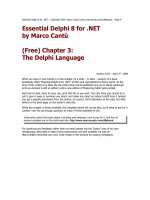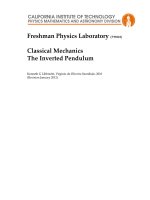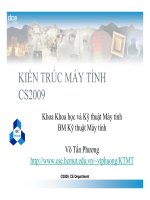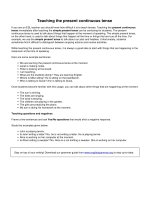Chapter 3 the present continuous
Bạn đang xem bản rút gọn của tài liệu. Xem và tải ngay bản đầy đủ của tài liệu tại đây (56.29 KB, 6 trang )
CHAPTER 3. THE PRESENT CONTINUOUS
1. Uses of the present continuous
In English, the Present Continuous tense is usually used to express continuing, ongoing
actions which are taking place at the moment of speaking or writing. In the examples
given below, the verbs in the Present Continuous tense are underlined.
e.g. Right now I am cooking supper.
At the moment the plane is flying over the Gulf of St. Lawrence.
The Present Continuous tense is often used in conversation.
e.g. "What are you doing?"
"I am working on my English assignment."
Occasionally, the Present Continuous tense is used to refer to a future event.
e.g. We are leaving tomorrow.
2. Formation of the present continuous
The Present Continuous tense of any verb is formed from the Simple Present of the
auxiliary to be, followed by what is generally referred to as the present participle of the
verb.
The present participle of a verb is formed by adding ing to the bare infinitive. For
instance, the present participle of the verb to work is working.
Thus, the Present Continuous tense of the verb to work is conjugated as follows:
I am working
you are working
he is working
she is working
it is working
we are working
they are working
3. Spelling rules for the formation of the present participle
Some verbs change their spelling when the ending ing is added to form the present
participle.
a. Verbs ending in a silent e
When a verb ends in a silent e, the silent e is dropped before the ending ing is added.
For example:
Infinitive
to close
to dine
to leave
to move
Present Participle
closing
dining
leaving
moving
1
However, when a verb ends in an e which is not silent, the final e is not dropped before
the ending ing is added. For example:
Infinitive
to be
to see
Present Participle
being
seeing
b. Verbs ending in ie
When a verb ends in ie, the ie is changed to y before the ending ing is added. For
example:
Infinitive
to die
to lie
Present Participle
dying
lying
When a verb ends in y, no change is made before the ending is added. For
example:
Infinitive
to fly
to play
Present Participle
flying
playing
c. One-syllable verbs ending in a single consonant preceded by a single vowel
Except in the case of the final consonants w, x and y, when a one-syllable verb ends in a
single consonant preceded by a single vowel, the final consonant must be doubled before
the ending ing is added. The reason for this is to reflect the fact that the pronunciation of
the single vowel does not change when the ending ing is added.
English vowels have a variety of pronunciations. For instance, each English vowel has
two contrasting pronunciations, which are sometimes referred to as short and long.
Vowels which are followed by two consonants, and vowels which are followed by a
single consonant at the end of a word, are generally pronounced short. In contrast,
vowels which are followed by a single consonant followed by another vowel are
generally pronounced long.
In the table below, the underlined vowels in the left-hand column are pronounced short;
whereas the underlined vowels in the right-hand column are pronounced long. For
example:
Short Vowels
Long Vowels
fat
fate
tapping
taping
let
delete
win
wine
filling
filing
not
note
hopping
hoping
flutter
flute
Thus, in the case of most one-syllable verbs ending in a single consonant preceded by a
single vowel, the vowel is pronounced short. In order to reflect the fact that the vowel is
also pronounced short in the corresponding present participle, except in the case of w, x
2
and y, the final consonant must be doubled before the ending ing is added.
In the following examples, the consonants which have been doubled
are
underlined. For example:
Infinitive
to nod
to dig
to run
to clap
to set
Present Participle
nodding
digging
running
clapping
setting
When a verb ends in w, x or y preceded by a single vowel, the final consonant is not
doubled before the ending is added. For example:
Infinitive
to draw
to fix
to say
Present Participle
drawing
fixing
saying
It should also be noted that when a verb ends in a single consonant preceded by two
vowels, the final consonant is not doubled before the ending is added. The reason for this
is that two vowels together are generally pronounced long. For example:
Infinitive
to rain
to read
to meet
to soak
Present Participle
raining
reading
meeting
soaking
d. Verbs of more than one syllable which end in a single consonant preceded by a
single vowel
When a verb of more than one syllable ends in a single consonant other than w, x or y
preceded by a single vowel, the final consonant is doubled to form the
present participle only when the last syllable of the verb is pronounced
with the heaviest stress.
For instance, in the following examples, the last syllables of the verbs
have the heaviest stress, and the final consonants are doubled to form
the present participles. In these examples, the syllables pronounced
with the heaviest stress are underlined. For example:
Infinitive
to expel
to begin
to occur
to omit
Present Participle
expelling
beginning
occurring
omitting
When a verb of more than one syllable ends in w, x or y, the final consonant is not
doubled before the ending ing is added. In the following examples, the
syllables pronounced with the heaviest stress are underlined. For
example:
3
Infinitive
to allow
to affix
to convey
Present Participle
allowing
affixing
conveying
When the last syllable of a verb is not pronounced with the heaviest stress, the final
consonant is usually not doubled to form the present participle. For
instance, in the following examples, the last syllables of the verbs do
not have the heaviest stress, and the final consonants are not doubled
to form the present participles. In these examples, the syllables
pronounced with the heaviest stress are underlined. For example:
Infinitive
to listen
to order
to focus
to limit
Present Participle
listening
ordering
focusing
limiting
If necessary, a dictionary can be consulted to determine which syllable of a verb has the
heaviest stress. Many dictionaries use symbols such as apostrophes to indicate which
syllables are pronounced with the heaviest stress.
It should be noted that British and American spelling rules differ for verbs which end in a
single l preceded by a single vowel. In British spelling, the l is always doubled before the
endings ing and ed
are added. However, in American spelling, verbs ending with a single l follow the same
rule as other verbs; the l is doubled only when the last syllable has the
heaviest stress. In the following examples, the syllables with the
heaviest stress are underlined. For example:
Infinitive
to signal
to travel
to compel
to propel
Present Participle
American Spelling
signaling
traveling
compelling
propelling
British Spelling
signalling
travelling
compelling
propelling
From these examples it can be seen that the American and British spellings for verbs
ending in a single l differ only when the last syllable does not have the heaviest stress.
4. Questions and negative statements
a. Questions
In the Present Continuous, the verb to be acts as an auxiliary. As is the case
with other English tenses, it is the auxiliary which is used to form
questions and negative statements.
To form a question in the Present Continuous tense, the auxiliary is
placed before the subject. For example:
Affirmative Statement
I am working.
Question
Am I working?
4
You are working.
Are you working?
He is working.
Is he working?
She is working.
Is she working?
It is working.
Is it working?
We are working.
Are we working?
They are working.
Are they working?
b. Negative statements
To form a negative statement, the word not is added after the auxiliary. For
example:
Affirmative Statement
I am working.
You are working.
He is working.
She is working.
It is working.
We are working.
They are working.
Negative Statement
I am not working.
You are not working.
He is not working.
She is not working.
It is not working.
We are not working.
They are not working.
c. Negative questions
To form a negative question, the auxiliary is placed before the subject, and the word not
is placed after the subject. However, when contractions are used, the contracted form of
not follows immediately after the auxiliary. Although there is no universally accepted
contraction for am not, the expression aren't I? is often used in spoken English.
For example:
Without Contractions
Am I not working?
Are you not working?
Is he not working?
Is she not working?
Is it not working?
Are we not working?
Are they not working?
With Contractions
[Aren't I working?] - used in speaking
Aren't you working?
Isn't he working?
Isn't she working?
Isn't it working?
Aren't we working?
Aren't they working?
d. Tag questions
Tag questions are also formed using the auxiliary. In the following examples, the tag
questions are underlined. In spoken English, aren't I? is often used as a tag
question. For example:
Affirmative Statement
I am working.
You are working.
He is working.
She is working.
It is working.
We are working.
They are working.
Affirmative Statement with Tag Question
I am working, am I not?
You are working, aren't you?
He is working, isn't he?
She is working, isn't she?
It is working, isn't it?
We are working, aren't we?
They are working, aren't they?
5. Comparison of the uses of the simple present and present continuous
As pointed out in Chapter 1, the Simple Present tense may be used for stating general
truths, and for referring to actions which occur at regular intervals. In the following
5
examples, the verbs in the Simple Present tense are underlined.
e.g. Nova Scotia is a Canadian province. Geese fly south every winter.
In contrast, the Present Continuous tense is usually used to refer to ongoing actions
happening at the time of speaking or writing. In the following examples, the verbs in the
Present Continuous tense are underlined.
e.g. Right now, I am visiting the province of Nova Scotia. At the moment, a flock of
geese is flying overhead.
6









